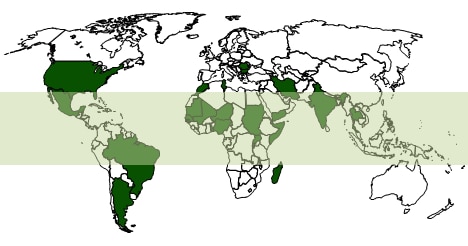Key points
- Mycetoma is caused by certain bacteria and fungi that are found in soil, plant matter, and water.
- It is most common in tropical and subtropical areas of Africa, Latin America, and Asia.
- Mycetoma causes painless masses under the skin that grow larger over time.
- Infections can spread and cause infections in other parts of the body including bones, sometimes leading to amputation.
- People who get mycetoma often become disabled and experience stigma.

Overview
Mycetoma is a disease caused by certain types of bacteria and fungi found in soil, plant matter, and water. These bacteria and fungi may enter the body through a break in the skin, often on a person’s foot.
Mycetoma causes painless masses underneath the skin. Most cases occur in equatorial regions of Africa, Latin America, and Asia known as the “mycetoma belt." It is more common among men than women and farmwork increases risk.
Diagnosis is made by laboratory testing of samples taken from the infected area. Mycetoma is treated with antibiotics or antifungals, depending on whether the infection is caused by bacteria or fungi. Surgery is sometimes needed to cut away the infected tissue. Wearing shoes might help prevent mycetoma.
World Health Organzation (WHO) Course
Types
Mycetoma can be caused by bacteria (actinomycetoma) or fungi (eumycetoma). Both types of infections look the same. Actinomycetomas progress to bone invasion more rapidly than eumycetomas. Actinomycetomas also occur more frequently on the chest, abdomen, and head compared with eumycetoma, which occurs primarily on the extremities.
Symptoms
Symptoms are similar for bacterial and fungal mycetoma. Both appear as firm, painless masses under the skin. These masses usually appear on a person’s foot but can form anywhere on the body.
Mycetoma masses start small, but over time they can grow larger and develop oozing sores. The affected limb can become deformed or unusable.
The discharge from the oozing sores can contain sand-like particles called "grains," that can be white, yellow, red, brown, or black. Because lesions are usually painless and slowly progressive, time from initial infection to initiation of care varies from months to years.
If left untreated or treatment fails, it can spread to other areas of the body and even result in blood infections. Long-term mycetoma can eventually destroy the underlying muscle and bone.
Exposure risks
Mycetoma is a health problem in equatorial regions of Africa, Latin America, and Asia known as the “mycetoma belt."

In the Americas, actinomycetoma is more common while both actinomycetoma and eumycetoma can be commonly diagnosed in Africa and Asia.
Risk factors
Mycetoma affects people of all ages and is more common in men. Many people with mycetoma work in agricultural jobs, such as farmers and livestock herders. People affected by mycetoma often live in remote areas where they have limited access to healthcare and medications. Mycetoma can cause severe physical disabilities that can force people to stop working and cause stigma.
How it spreads
Mycetoma is usually caused when skin is broken and exposed to soil or water containing the causative bacteria or fungi. These germs can enter the body through wounds or other small skin injuries, like a thorn prick. It is not known why only some people develop mycetoma, but aspects of the environment and living conditions are likely involved. Mycetoma does not spread between people.
Reducing risk
Healthcare providers and researchers believe that wearing shoes might prevent injuries that can lead to mycetoma. Early detection and treatment, before symptoms cause serious effects, can reduce disabilities from mycetoma and may cure the condition.
A roadmap for global mycetoma control
Quick facts
The number of people with mycetoma worldwide is not known. There were 19,494 cases reported in a 2020 review of scientific articles between 1876 and 2019. The actual number of cases is likely substantially higher.
Rare in the United States
Mycetoma has rarely been reported in the United States in recent decades. Data from 2017 to 2021 found 238 cases of eumycetoma. Most patients were female, over 65 years old, and lived in urban areas. There is low risk for travel-associated mycetoma.
Diagnosis
To diagnose mycetoma, healthcare providers take a small sample (biopsy) of the infected area. Biopsies are examined in laboratories.
An X-ray or ultrasound may be used to assess damage to muscle and bone. Patients can avoid long-term infection and amputation by seeking care and detecting and treating mycetoma early.
Treatment and recovery
Therapies that work against mycetoma are limited. The treatment for mycetoma depends on whether it is caused by bacteria (actinomycetoma) or fungi (eumycetoma).
Actinomycetoma is usually treatable with antibiotics, and surgery is usually not needed. Eumycetoma is usually treated with long-term antifungal medicine. However, this treatment may not be completely effective. Sometimes surgery or amputation are necessary to cut away the infected tissue.
More fungal disease resources
Resources
- World Health Organization: Mycetoma
- Mycetoma: Training of health workers at national and district levels on skin-NTDs
